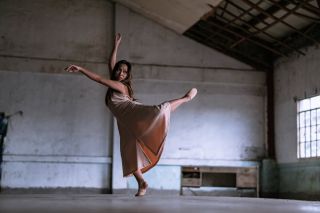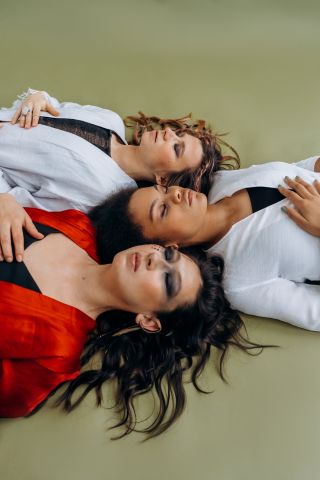We often talk about the perfect thin and toned body and its negative impact on body image. When most of us do not measure up to the ideal body shape, we do not feel good about our bodies, how we move, or how we physically feel in our bodies. In addition to the body ideal and our body image, body awareness can also guide our movement patterns. What is body awareness? Can it make us feel better in our bodies?
What Is Body Awareness?

Source: pixabay/Pexels
In her recent book, Rechoreographing Learning: Dance as a Way to Bridge the Mind-body Divide in Education (2022), Sandra Cerny Minton, a dance educator, highlights the role body awareness has in learning and performing dance. Her text, however, can be very useful for exercisers who want to feel better when moving.
Execution of all physical movement, Minton reminds us, depends on the human sensory system that includes:
- Exteroception, which is used to become aware of the environment through vision, hearing, touch, smell, or taste. Vision is the most commonly used sense to produce an action or movement response. For example, we use vision when we follow an instructor’s body in a group fitness class or look at the mirror to assess our performance. We use the auditory sense when we follow verbal cues or use music to accompany our exercise. We engage the tactile sense when a personal trainer uses touch to guide our movement or when we use equipment to train.
- Interoception, which is an ability to sense one’s internal bodily state. This is the least researched sensory system.
- Proprioception, which is an awareness of how one’s body is moving. This includes awareness of gravity, shapes at joints, and the body’s location in space. This is the kinesthetic sense that has receptors in muscles, fascia, tendons, ligaments, and joints. Through kinesthetic sense and proprioception, we become aware of how our bodies move.

Source: Mariam Antadze/Pexels
How Does It Work?
As proprioception detects how bodies move in space, it directly informs body awareness. In fact, Minton asserts that even a simple everyday task would be impossible without proprioception making us aware of our bodies. However, we tend ignore it because the exteroceptive senses dominate our movement activities. For example, in a dance or group exercise class, we focus on the mirror image of our bodies or the teacher’s body—this uses vision—that can distract proprioception and body awareness.
For most of us, it seems easier to let vision and hearing guide our exercise. Some may prefer to “tune out” entirely and not focus on their exercise at all. Kinesthetic sense and proprioception operate also unconsciously: We do not necessarily need to think about how we move, as some of it is automated. However, Minton explains, body awareness is also the conscious sensation of movement.
Paying Attention
When we engage body awareness, the proprioceptors send messages to the brain. The brain then works to initiate and control movement. This means that our brains—what we think—and our moving bodies are in a constant interaction that can be consciously enhanced. Minton reiterates that, “recognizing and describing one’s bodily sensations requires paying attention or attending to them on the mental level. Otherwise, such sensations would remain beyond one’s conscious realm and escape recognition and subsequent description.” (p. 70)
To be fully aware of our bodies, we then need to pay attention to internal bodily feelings. Unlike tuning out, the conscious focus on body awareness turns our attention to positive feelings of our own movement ability. This can make us feel better about our bodies, feel better in our bodies, and improve general well-being.
Minton adds that “focused awareness” (p. 70) can be practiced. We can consciously focus our attention on a specific body part or movement. This requires deliberately attending to a movement task and filtering out other potential “stimuli.” This type of attention may be already familiar to yoga or other Eastern movement practitioners or Pilates practitioners, but can be used during any exercise or movement session to learn how to move more fully and efficiently.

Source: Jansel Ferma
Minton notes that the ability to pay attention is important in dance when learning intricate technique or performing a complicated choreography. Dancers are often credited for their body awareness and skillful movement ability. However, we can put body awareness in practice in any exercise setting to move gracefully, efficiently, safely, and powerfully.

Michail Nilov/Pexels
How to Practice Body Awareness?
Since employing body awareness requires practice, Minton provides specific exercises to pay conscious attention to how we move. We can try the following explorations that I have slightly modified for an exercise context:
- To sensitize ourselves to body awareness, we can first explore it when still. Take time to lie down on a mat or soft carpet. Close your eyes. Scan your entire body for any bodily feelings you are experiencing.
- Sit in a chair and slump forward. Remain seated while you arch your back. Then assume a neutral position with your shoulders aligned above your hips. Which position felt more comfortable based on your bodily feelings?
- Perform an exercise such as a hamstring stretch as you usually do it. Use a mirror if available. Then turn away from the mirror if you are using one and close your eyes to exclude vision. Perform the same exercise. Consider the bodily sensations when performing your exercise in these two ways.
- Perform an exercise sequence such as a lateral pull. Try performing the sequence in two different ways. First, perform it while focusing internally on how the movements feel in your body. For example, consider how your shoulder blades, elbows, and head moved. Did your abdominals, back muscles, or leg muscles engage? Was some aspect of the exercise more difficult than others? What other bodily feelings did you have? Second, perform the movement sequence without an attention to detail. Were your movement performances different?
After being sensitized to body awareness in these exercises, we can then use it in all workout sessions. Focusing on the bodily sensations while moving can improve the enjoyment of the workouts, help us perform more confidently, and make us feel better about our unique bodily abilities.















+ There are no comments
Add yours